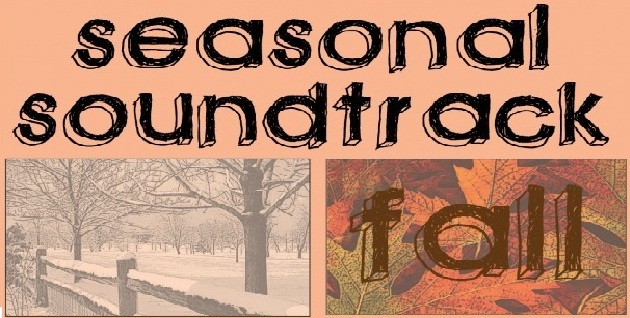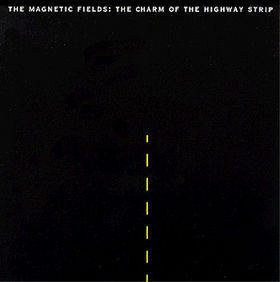
The Magnetic Fields
The Charm of the Highway Strip
[Merge Records; 1994]
The passage of time manifests itself in constant change, and it is during the autumn that this change is most prominent. Leaves turn bright yellows and reds, reminding us that the year’s end is growing ever closer, and making us all wish we were vampires so that we could live forever. I’m not so sure about the truth of that last part, but if it applies to you, then The Charm of the Highway Strip is a perfect fall record: all about change, vampires, and the experience of both these things. A cursory glance at the album’s packaging reveals no vampires, but a particular fixation on roads and travel, with song titles such as “Lonely Highway,” “Long Vermont Roads,” and “Fear of Trains.” Place names and other geographic metaphors and similes figure prominently in Stephin Merritt’s songwriting, as do vampires. “Crowd of Drifters,” for example, is narrated by what appears to be a traveling-salesman-turned-vampire, constantly moving from place to place but fixed in time, and “I Have the Moon” finds another apparent vampire singing to its companion. It is only fitting that in an album so fixated on themes of constant change in time and place we find reference to beings on whom time has no effect, who instead observe the effects of time on things around them. Like them, we may feel that we haven’t changed so much in just one year, but when we non-vampires witness the change of colors in the leaves around us, it serves to us as a reminder that time is forever in motion, and that we are drifting right along with it.
– Harrison Suits Baer
Recommended Listening
“Long Vermont Roads”
“Fear Of Trains”

The Mountain Goats
All Hail West Texas
[Emperor Jones; 2002]
Autumn has always meant something different to me than common literary conceit would indicate. Maybe it’s the cyclical nature of school, the beginning again of routine and the desperate hope that this year is the year that makes it. The Mountain Goats’ All Hail West Texas is not removed from this, sometimes infernal, longing. And that is what it is, in a lot of ways: a record about longing. There is a necessary fall of character that makes any speaker worth conversation, but this record is, at its flooded heart, about what comes after. “Color in Your Cheeks,” in its bizarre removal and burnt imagery, is sobering both in sentiment and necessity, the endless summer that all too often isn’t. Then “Jenny” and all her promises. “How much better, how much better, could my life get?… no outstanding warrant for my arrest.” To mistake John Darnielle’s scene for irony is to deny the gravity what his story epilogues, and the juxtaposition of movement and an implied requirement of escape conjures in the record that fiery call to highway, thirst for holy forgetfulness, that is highly autumnal. Any conversation about All Hail West Texas that avoids its production aesthetic is enviable, but doesn’t that crackle remind you of something? “Nine days old.” This is memory without the lens of effected distance, heartbreak and abuse in the past tense, but battered all the same. “I want to go home, but I am home.” That hope, that “Will I see you there?”… what better to usher into a barren death of winter, the highways all blocked and metros closing you from old friends? Is it falling or dying? Is it running?
– FM Stringer
Recommended Listening:
“Jenny”
“Color In Your Cheeks”

The National
Boxer
[Beggars Banquet; 2007]
In a poetic sense, the fall season is associated with the theme of change and sorrow. It’s the stage in a person’s life before things metaphorically turn cold and grey, as evidenced in John Keats’ classic poetic ode, “To Autumn.” The National’s 2007 full-length, Boxer, certainly comes close as possible to fitting that description. In what may be their best work in their catalog, Boxer is rich in its texture with glistening melodies dispersed in each of the 12 tracks. Vocalist Matt Berninger’s dynamic baritone and powerful-yet-playful lyrics pack the album with an emotional punch. That dichotomy of melancholy mixed with the beautiful makes Boxer an ideal album to listen to during the moody season that is fall.
– Ace Ubas
Recommended Listening:
“Fake Empire”
“Start A War”

Neil Young
Harvest
[Reprise; 1972]
Harvest may well be Neil Young’s most famous record, but it’s also his most well-equipped for autumn. As the heat of summer gives way to the chill of fall, our personalities go through a natural shift. We become a little less cheery as our instincts to wrap ourselves in blankets and sip warm tea take over. Harvest is the perfect anecdote: organic and electronic country music sounds with vibrant messages in each line.
“Heart of Gold,” the album’s most beloved track, has Young in a place of longing, a feeling with a strange knack of showing up again and again right around this time each year. On “The Needle and the Damage Done,” his longing turns to sorrow, his voice and guitar openly weeping for beloved artists who’d died of heroin addiction. Harvest captures mountainous emotions that evoke the crumbling and crackling of dried leaves and trees gone bare. The fight in his voice throughout — he’s lamenting but not defeated — is what reminds us of the sun through the branches and the togetherness and spirit of the season.
– Andrew Bailey
Recommended Listening:
“Heart Of Gold”
“The Needle and the Damage Done”
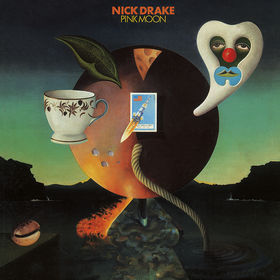
Nick Drake
Pink Moon
[Island; 1972]
Unlike my other selection on this list, Pink Moon actually illustrates what fall sounds like. As I sat around, and imagined what the world would be like if the palm fronds near me suddenly took an orangish hue, Nick Drake’s near whispered lyrics and delicately-fingered guitar parts romanticized an idea that at the time was pure fantasy. Pink Moon is an escape into a world where fall actually exists. It might be predictable to associate folk and fall, but there’s something about Drake’s voice specifically that welcomes comparisons to autumnal imagery. When I hear the opening chords to the title track, my head is filled with visions of cool winds and bunches of leaves fluttering to the ground and though I might not have much experience with the season itself, Pink Moon represents what my conception of fall might be like.
– Colin Joyce
Recommended Listening:
“Pink Moon”
“Harvest Breed”
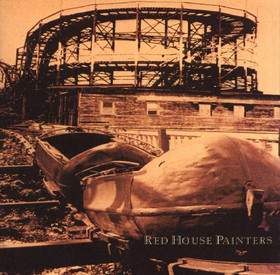
Red House Painters
Red House Painters (Rollercoaster)
[4AD; 1993]
I’m sure you’ve noticed that every year when fall rolls around the sunsets start to become a lot more orange, as if rather than merely sinking below the horizon the sun has decided to smear itself across the sky. The effect is an impressive one; as if the whole world slowed down, and that word – slow – is exactly how I characterise this time of year, so what type of music is a better fit than slowcore? For me, the central text of slowcore is Red House Painters’ 1993 sophomore epic Red House Painters – or Rollercoaster for those of us who want an easy way to distinguish it from their follow up to this, which they also decided to self-title. From the sepia-toned cover to the guitar tones echoing into the recording’s atmosphere, the whole thing smacks of fall. Rollercoaster is a long album, reaching over 70 minutes. In that time Mark Kozelek covers the beginning of fall with the last of the summer fun (beaches and theme parks) to the onset of winter (grey air and cold, damp attics). And of course, there’s love and heartbreak, but that goes without saying.
For me, fall is the most evocative season, and to sum it up well you need a real wordsmith – and, if anything, Mark Kozelek is exactly that. Practically every verse paints a picture or tells a story, but perhaps none sums up better my feeling about fall than this from “Rollercoaster”: “There’s the sun going down / reminding me that I’ll never be able to live this day again / except in memory.”
– Rob Hakimian
Recommended Listening:
“Katy Song”
“Dragonflies”
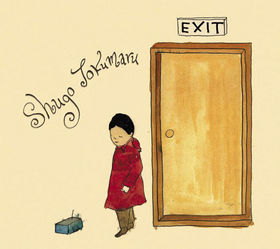
Shugo Tokumaru
Exit
[Almost Gold; 2007]
More than any other temperate season, fall exhibits the transforming colorations of lush foliage. Shugo Tokumaru’s debut record, Exit, demonstrates the same kind of transformative quality. It’s a collection of songs that not only evokes the bright colors of vivid autumn leaves, but also their changing-of-colors – demonstrated by Shugo’s steady introduction of new and complementary sounds. This includes the woodwind instruments on “”Cocca,” which sounds like a natural progression of the melodicas on “Green Rain.” Such implementations are reminiscent of fall’s transforming autumn leaves – changing colors in a drastic yet seamless fashion.
Best of all, Exit is a listening experience that relies on good spirits and perfectly-singable melodies – the kind of music that makes you feel genuinely alive. I remember playing the record back in late 2007 just as the season had entered its changing of colors. There couldn’t have been a more fitting soundtrack.
– Ryan Studer
Recommended Listening:
“Parachute”
“Green Rain”
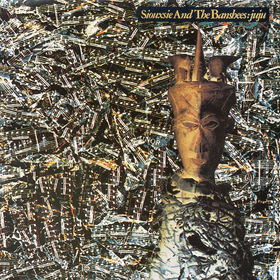
Siouxsie and the Banshees
Juju
[Polydor; 1981]
Some albums are autumnal based on their ability to elegantly decay before our ears, stripping away the layers of overdubs and swabbing the waxy excess; this is why folk albums often fall comfortably into this sphere. Or, albums might gain this seasonal distinction purely by association with their original release date or personal memories. (Elliott Smith is an important also-ran to note, as we commemorate his untimely passing on October 21, 2003, even though his themes aren’t inherently tied to the season.)
Then, there are those albums that hang prominently in the night sky at least one month of the year: October. Siouxsie and the Banshees leapt out of the cemetery gates in 1981 to provide us with an excellent Halloween soundtrack for years to come. And no, this isn’t the half-assed result of searching for the word “Halloween” on iTunes. It’s the sinister undertone of lines like “I heard a rumor / what have you done to her?” (“Arabian Knights”), each delivered with that witchy sensibility. Budgie’s percussive impact boils beneath every spellbinding guitar line, reining in Juju from becoming little more than a showcase for John McGeoch’s guitar. All the elements are there and bigger than ever before.
It also helps that the band is held as one of gothic rock’s chief forebears, and if you’re looking to create a Halloween playlist for parties or late-night drives, any track from “Spellbound” to “Voodoo Dolly” will work nicely next to, say, “Bela Lugosi’s Dead.” But if your playlist selections are as obvious as my spooky-time adjectives, you’ll opt for “Halloween” alongside “Scary Monsters (And Super Creeps)” and the Ghostbusters theme.
– Michael Tkach
Recommended Listening:
“Spellbound”
“Halloween”
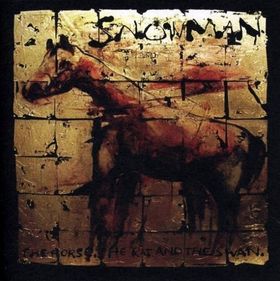
Snowman
The Horse, The Rat, and The Swan
[Dot Dash; 2008]
You might as well add Snowman’s latest to this list as well. Except where Absence is willing to slip off into fits of restless sleep, The Horse, The Rat and The Swan is a wide-eyed adrenaline-doused massacre through an abandoned insane asylum. Gothic throaty baritones contrast with Iggy Pop/Frank Black blasts of throat grinding fury and violent tribal drums resonate from rusty walls. I’m not quite sure what about this record reminds me of the season, but The Horse, The Rat and The Swan has the ability to bring a certain amount of darkness with it.
– Will Ryan
Recommended Listening:
“Daniel Was A Time Bomb”
“The Horse”

Sunn O)))
Black One
[Southern Lord; 2005]
Sunn O)))’s Black One is the perfect aural preparation for hibernation at the tail end of the fall right before the snow starts to descend. There’s some of black metal’s naturalism embedded in Black One‘s frigid core that speaks to decaying leafless trees and the quieting of the earth like northern plains evacuating of life at the onset of winter – the lone voices of ghosts drifting like barbed dandelion corpses on the wind. Or something like that.
– Will Ryan
Recommended Listening:
“Cursed Realms (Of The Winter Demon)”
“Orthodox Caveman”
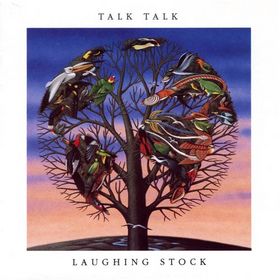
Talk Talk
Laughing Stock
[Verve; 1991]
It’s worth wondering whether this album was created for fall days; simply looking at that cover, with a leafless, solitary tree against the cold horizon, inspires certain feelings of emptiness. Heavily influenced by the looseness of experimental jazz, Laughing Stock was Talk Talk’s full-fledged sonic makeover after nearly a decade of popular mainstream success in the new wave genre. The background story to this album is the stuff of cult legend: a bitter divorce from their longtime home at EMI, insisting on candles and incense in the studio, and the antics of a brooding, enigmatic frontman endows a somber mood to the already-austere ambiance that this album creates. Complete with minimal, dissonant instrumentation and singer Mark Hollis’ anguished, mumbled vocals, it’s an unbelievably sad, stark soundtrack for the quietness of November.
– Arika Dean
Recommended Listening:
“Myrrhman”
“After The Flood”
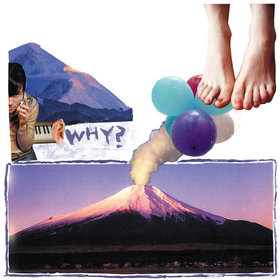
Why?
Elephant Eyelash
[Anticon; 2005]
Part of what makes WHY’s hip-hoppin’-est record so appropriate for the season is its panic. Yoni’s vocals feel nearly always a breath ahead of a track’s rhythm, to an effect that enacts the emotional urgency of the record: racing the approaching decay, inevitable loss and inescapable death. There is so much ordering to do before day is eclipsed, letters to be written to friends and ex-lovers, memoirs to draw in the unset concrete of some Texas boulevard, intents and wishes to make clear like a Last Will of intangible things. The theatre of life is forever pushing individual drama to Curtain, stumbling through acts like a drunk on puppetstrings, and only if we are opportunistic do we mirror Yoni’s dominance of soliloquy. This is an album horrifyingly aware of mortality. Its meditations are of guilt and regret and some unbearable understanding of history on a timeline larger than personal life but intimate enough to feel like rain. “Your legs were two skinny dolphins swimming.” It’s about shame and failure and lightlessness and perhaps the curse of life in the face of an oncoming end. Maybe this is why Elephant Eyelash‘s speaker’s most sincere moment is a confession of desire to join the leaves in compost, filtering and fertilizing and maybe growing something, one day.
– FM Stringer
Recommended Listening:
“Light Leaves”
“Crushed Bones”

Yo La Tengo
I Can Hear the Heart Beating as One
[Matador Records; 1997]
I Can Hear The Heart Beating As One could have just been sixteen tracks — “Autumn Sweater” on repeat — and I still would have seen fit to include it here. Fortunately, that’s not the case, as the track is just one especially bright highlight in a veritable constellation of 90s indie tropes. Skewed Americana? Check (“We’re an American Band”). Refashioned classics from a halcyon, sunshiny past? Check (“Little Honda” and “My Little Corner of the World”). Assured fuzz-rock? Please see “Sugarcubes,” and while you’re at it, check out its hilarious video, starring David Cross as a hapless rock n roll aesthete trying to teach the members of Yo La Tengo how to get their Motley Crue on. But the twin heartbreaking centerpieces of the album are “Stockholm Syndrome” and “Autumn Sweater.” The former is brief, acoustic, and devastating, with a feedback-drenched solo unexpectedly appearing halfway through that reflects the singer’s frustration with his unsure love, as evidenced by lyrics like, “What’s the matter? Why don’t you answer? What’s the matter with me?” As for “Autumn Sweater,” well, ask any fan what their favorite Yo La Tengo songs are; “Autumn Sweater” is all but guaranteed to show up in their top three. In fact, it’s difficult not to fall for the song. Has there ever been a more achingly accurate summary of a stagnant, dying relationship than the chorus’s final question? “We could drift away, wouldn’t that be better? Me with nothing to say, and you in your autumn sweater.” A haunted organ whines, tender chords resolve, and life goes on, all the better for having I Can Hear The Heart Beating As One in it.
– Joshua Becker
Recommended Listening:
“Autumn Sweater”
“My Little Corner Of The World”

